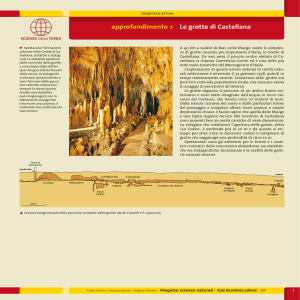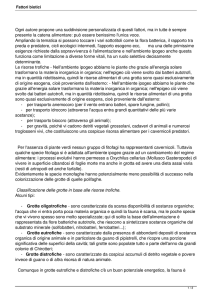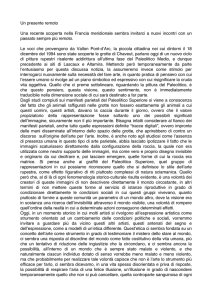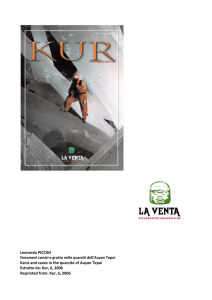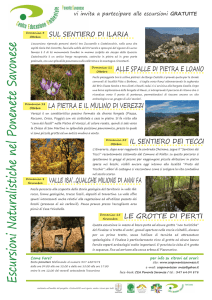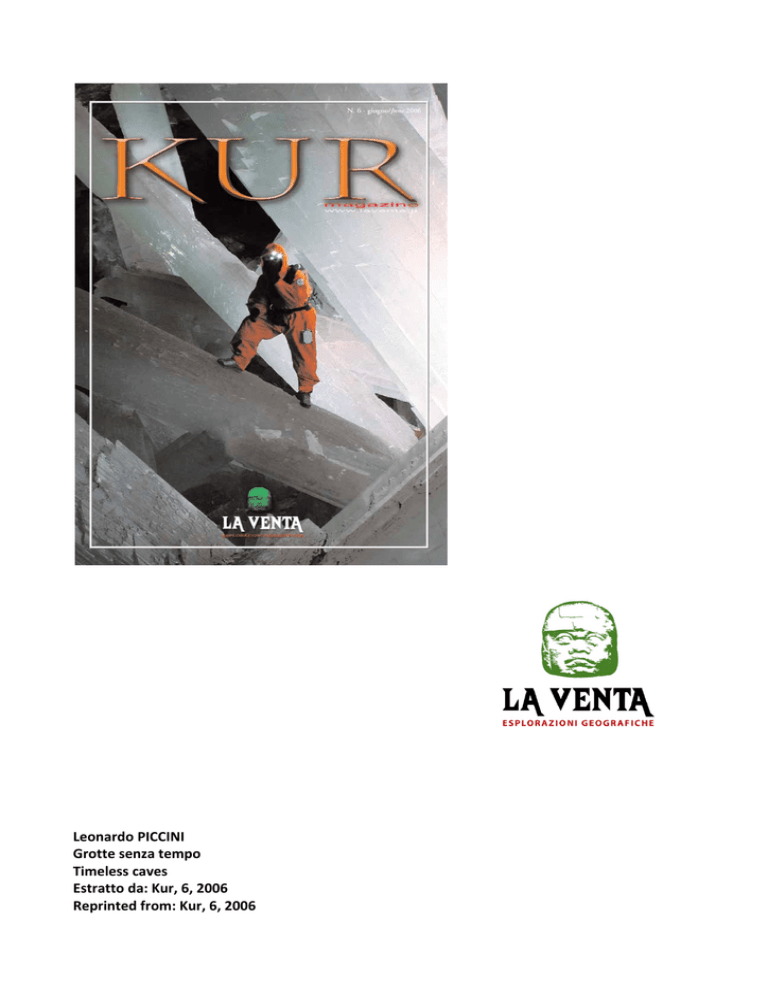
Leonardo PICCINI Grotte senza tempo
Timeless caves Estratto da: Kur, 6, 2006 Reprinted from: Kur, 6, 2006 ESPLORAZIONI GEOGRAFICHE
6
Torri di quarzite emergono tra le nubi sull’Auyan-tepui / Towers of quartzite rising out from clouds on the Auyan-tepui
7
ESPLORAZIONI GEOGRAFICHE
Leonardo Piccini
Timeless Caves
Al confine tra Venezuela, Brasile e Guayana si trova una delle
zone più straordinarie del nostro pianeta: è la Gran Sabana.
Il paesaggio, unico al mondo, è caratterizzato da montagne
di forma tozza, che prendono il nome di tepui, con ampi
pianori sommitali delimitati da pareti rocciose alte anche più
di 1000 metri, che si ergono improvvise dalla foresta pluviale. La zona è contraddistinta da un clima particolarmente
umido. L'acqua scorre ovunque. Cade dalle montagne, con
altissime cascate, tra cui il famoso Salto Angel, la cascata
perenne più alta al mondo. Fluisce nelle pianure in un intrico di canali e fiumi, le cui acque hanno un colore caratteristico, simile al tè, dovuto alla presenza di sostanze organiche.
La singolarità di questi luoghi è dovuta soprattutto alla loro
storia geologica, iniziata oltre tre miliardi di anni fa, quando
il nostro pianeta era ancora giovane. Questa regione, infatti,
fa parte di quello che i geologi chiamano “Scudo della
Guayana”, una delle porzioni più antiche di tutta la crosta
terrestre. Le montagne sono formate da sabbie silicee cementate (le quarziti) deposte circa due miliardi di anni fa, quando America meridionale ed Africa erano riunite in un unico
At the border between Venezuela, Brazil and Guyana sits
Gran Sabana, one of the most extraordinary areas of our
planet. Its unique landscape is characterised by the presence of
squat mountains, scattered amongst the rainforest. Named
tepui, their tops feature wide plateaux surrounded by rocky
walls more than 1000 metres high. The whole area is characterised by a particularly humid climate. Water flows everywhere. It falls from the mountains, with very high cascades,
amongst which is the Salto Angel (Angel Falls), the tallest
waterfall in the world. It flows in the plains, in a mesh of
rivers and canals, whose waters have a distinct tea-like
colour, due to the presence of organic matter.
The peculiarity of these places is mostly due to their geological
history, which started more than 3 billion years ago, when
our planet was still in its infancy. The area belongs to what
geologists call the “Guyana Shield”, one of the oldest parts of
Earth’s crust. The mountains are made of cemented silica
sands (quartzite), deposited more than two billion years ago,
when South America and Africa were still joined in a single,
large continent. The area remained stable for the longest
grande continente. Tutta la zona è rimasta per un tempo
lunghissimo stabile, al centro di questo supercontinente,
sino a che, circa 150 milioni di anni fa, Africa e America
meridionale iniziarono a separarsi, a causa di quel fenomeno
noto come “deriva dei continenti”. Ciò provocò cambiamenti sostanziali nella geografia di quei luoghi e la comparsa di fiumi che prima non esistevano.
È in questo periodo che si sono formati i bacini del Rio
delle Amazzoni e dell’Orinoco, i cui affluenti iniziarono a
incidere profondamente le antiche e durissime quarziti della
Gran Sabana. I canyon che si sono formati, ampliandosi,
hanno col tempo isolato le singolari montagne che oggi
chiamiamo tepui.
La loro particolare forma è determinata dalla costituzione
geologica, caratterizzata da strati rocciosi orizzontali, e dal
fatto che l'erosione provoca un arretramento parallelo delle
scarpate, riducendo progressivamente l’estensione delle
montagne, ma lasciandone sostanzialmente invariata la
quota ed il profilo. L’erosione non ha agito però solo in
superficie, ma ha scavato anche in profondità, formando
voragini profondissime e vere e proprie grotte, in cui cade
una parte delle acque che scorrono sui pianori sommitali e
che poi riemerge in spettacolari risorgenti ai piedi delle pareti o più in alto, in forma di cascate.
Si tratta, come è facile intuire di grotte molto particolari,
fosse solo per il fatto di essere scavate in rocce costituite quasi
esclusivamente da quarzo, uno dei minerali meno solubili
esistenti e quindi apparentemente non idoneo allo sviluppo
di cavità sotterranee.
Salvo casi particolari, come quelli delle grotte di origine vulcanica che si formano in seguito allo svuotamento dei condotti di flusso delle lave, quelle nei ghiacciai, dovute a processi di fusione, e quelle di origine meccanica, legate a crolli
o a movimenti di blocchi rocciosi, la maggior parte delle
cavità sotterranee si forma, infatti, in seguito a processi di
dissoluzione delle rocce in acqua.
Perché si formino cavità di grandi dimensioni occorre che i
normali processi di erosione che agiscono in superficie, ad
opera delle acque di ruscellamento, abbiano un effetto attenuato, lasciando tempo ai processi di dissoluzione sotterranea di ampliare i vani che si vanno formando e di costruire
una rete di condotti di drenaggio in grado di smaltire efficacemente le acque d'infiltrazione.
Questo può succedere per due motivi: o perché le rocce sono
ESPLORAZIONI GEOGRAFICHE
8
time, at the centre of this super-continent, until 150 million
years ago. Then, Africa and South America began to separate,
due to the continental drift, leading to substantial changes in
the geography of those areas and to the appearance of newlyformed rivers.
It was at that time that the basins of the Amazon and
Orinoco rivers, whose tributaries began to deeply etch the
ancient and very hard quartzite of Gran Sabana, were
formed. The canyons that originated in this way became
wider and wider in time, isolating the peculiar mountains we
now call tepuis.
Their singular shape was determined by their geological
structure, characterised by horizontal rock layers, and by the
fact that erosion led to the parallel retreat of escarpments, progressively reducing their extension while leaving both altitude
and profile untouched. Erosion, however, did not work just
on the surface but went underground too, creating very deep
shafts and fully-fledged caves. Part of the waters flowing on
the tops of the plateaux fall into such caves and then reemerge from spectacular resurgences at the foot of the walls, or
higher up as cascades.
It is easy to see how these are very peculiar caves, if nothing
else for being carved into rocks made almost exclusively of
quartz. This is one of the least soluble minerals existing in
nature, apparently poorly prone to the formation of underground caverns.
Exceptions aside, e.g., volcanic caves formed by the emptying
of the lava flux conduits, ice caves formed by melting and
those mechanically formed by collapse or shifts of rock masses,
most underground caves are formed by the dissolving of rocks
by water.
In order to create wide caverns, the normal erosion processes
that take place on the surface due to flowing waters must be
attenuated; this way, the underground dissolution processes
have the time to widen the forming cavities and to build a
network of draining conduits capable of efficiently disposing
of the seeping waters.
This can happen for two reasons: either because the rocks are
easily dissolved, as happens with limestone, dolomites and
gypsum, or because morphology and climate favour chemical
rather than physical alteration. In order to form caves within poorly soluble rocks, like quartzite, one could easy foresee
the need of very peculiar environmental conditions.
Time also plays a role in this. If solubility is modest, again, as
La tipica sagoma tabulare delle montagne della Gran Sabana / The typical table shape of Gran Sabana’s mountains
9
ESPLORAZIONI GEOGRAFICHE
Torri e fratture / Towers and fractures
facilmente solubili, come nel caso dei calcari, delle dolomie
o dei gessi, o perché l'assetto morfologico e le condizioni climatiche sono tali da favorire i processi di alterazione chimica a scapito di quelli fisici. Perché si possano formare grotte
in rocce poco solubili, come le quarziti appunto, occorrono,
come è facile immaginare condizioni ambientali molto particolari.
Anche il tempo gioca la sua parte. Se la solubilità è assai
modesta, come nel caso delle quarziti, è lecito pensare che
per formarvi delle grotte, occorra molto più tempo di quanto sia necessario per formare una grotta equivalente in un
calcare.
Viene quindi spontaneo chiedersi: quanto sono antiche le
grotte dei Tepui?
Le più antiche grotte del mondo?
Quando furono scoperte le prime grotte nelle quarziti del
M. Roraima, nell’ormai lontano 1974, la notizia ebbe del
sensazionale; almeno tra gli speleologi, abituati, come eravamo, a pensare che le grotte potessero formarsi solo nei calcari, o tutt’al più nei gessi, disdegnando tutte le altre rocce. A
rendere la cosa ancora più sensazionale, ci fu chi sostenne
potesse trattarsi delle più antiche grotte del mondo, vecchie
forse di centinaia di milioni di anni.
Anche noi, durante l’esplorazione degli abissi dell’Ayuan
Tepui, in Venezuela, fummo contagiati da questa sensazione, forse inconsciamente influenzati dal celebre romanzo di
Arthur Conan Doyle, “The Lost World”, in cui un gruppo
di esploratori scopre su queste inaccessibili montagne un
mondo rimasto immutato dal Mesozoico, con tanto di dinosauri e piante ormai estinte.
Ma è proprio necessario invocare tempi lunghissimi per la
formazione di queste grotte?
Valutare l’età di una grotta è sempre molto difficile, anche
perché, non essendo altro che un insieme di vuoti, non può
essere datata direttamente in nessun modo.
Applicando uno dei principi di base della geologia, possiamo
dire che l’età di una grotta deve essere compresa tra quella
che è l’età della roccia ospite e l'età dei più antichi sedimenti in essa contenuti.
it is the case with quartzite, it is conceivable that the formation of a cave would take much longer than it would in a
limestone.
The obvious question, then, is: how old are the Tepui caves?
The World’s most ancient caves?
When the first quartzite caves were discovered in Mount
Roraima, back in 1974, it was astounding news. Or at least
is was for speleologists, who until then were used to thinking
that caves could only form within limestone, or at most within gypsum, and disregarded any other kind of rock. Even
more impressive was the fact that someone claimed that they
could be the oldest caves in the world, possibly hundreds of
millions of years old.
We too, during our exploration of the abysses of Ayuan Tepui
(Venezuela), were infected with such a feeling, possibly influenced by A.C. Doyle’s novel “The Lost World” (in which a
group of explorers discovered, in these inaccessible mountains,
a pristine Mesozoic world complete with dinosaurs and
extinct vegetation).
But do we really need to envisage such a long time for the formation of these caves?
Assessing the age of a cave is always a difficult task because,
amongst other things, its being just a set of hollows does not
allow any direct dating method.
If we apply one of the basic principles of geology, we can say
that the age of a cave must be comprised between that of the
rock that surrounds it and the age of the oldest sediments present inside it.
Other considerations usually allow us to greatly narrow the
time span of possible ages. For example, most limestone caves
are less than 2-3 million years old, even though they are
carved within rocks that usually are tens of hundreds of million years old. This is due to the fact that earlier than 2-3
million years ago the conditions of the rocks could not allow
the formation of karst caves.
In the case of tepui’s quartzite, the rocks are way older, in the
range of 2 billion years. Very ancient rocks then, but their age
per se does not mean much. One could in fact have quite
recent caves inside extremely old rocks. Besides, defining the
La rete di fratture che tagliano la superficie sommitale dell’Auyan-tepui / The network of fractures cutting the top surface of Auyan-tepui
ESPLORAZIONI GEOGRAFICHE
10
Altre considerazioni ci permettono in genere di restringere di
molto l’intervallo di tempo delle possibili età. La maggior
parte delle grotte calcaree, ad esempio, benché siano scavate
in rocce che in genere hanno da qualche centinaio a qualche
decina di milioni di anni, hanno età solitamente inferiore a
2 o 3 milioni di anni; ciò è dovuto al fatto che in precedenza le rocce non si trovavano in condizioni tali da permettere
lo sviluppo di cavità carsiche.
Nel caso delle quarziti dei tepui, l’età delle rocce è enormemente maggiore, dell’ordine dei 2 miliardi di anni. Sono
quindi rocce antichissime, ma l’età della roccia, di per sé,
non dice molto. Posso infatti avere grotte molto recenti in
rocce antichissime. La definizione di “età di una grotta” è
poi tutt’altro che banale, come scritto altrove, in questa stessa rivista.
Ma torniamo alle nostre grotte dei tepui. In primo luogo si
tratta di capire quando hanno avuto inizio i processi che
hanno portato alla formazione delle grotte nelle quarziti.
Fenomeni di dissoluzione sono possibili già durante la formazione di una roccia, anzi, essi rappresentano uno dei
fenomeni più importanti della diagenesi, cioè di quell'insieme di processi che portano un sedimento sciolto, come una
sabbia, a diventare una roccia coerente, cioè un’arenaria.
Perché, però, questi fenomeni portino alla formazione di
veri sistemi di grotte, e non solo di cavità isolate, occorre che
l’acqua possa circolare nella roccia sotto l'azione della gravità. Questo ci porta a concludere che le grotte dei tepui devono essere più giovani delle valli circostanti in fondo alle quali
scorrono i fiumi in cui si riversano le acque catturate dai
sistemi sotterranei. In altra parole, le grotte possono essersi
formate solo a quote superiori a quelle del fondovalle e quindi successivamente all'incisione dei fiumi.
Abbiamo già detto che sino a circa 150 milioni di anni fa,
Africa e America del Sud erano unite e l’idrografia era probabilmente molto diversa. Sebbene alcune porzioni dei bacini dell’Orinoco e del Rio delle Amazzoni potrebbero aver già
avuto una disposizione simile a quella odierna, è assai difficile che l’erosione avesse già approfondito, allora, il reticolo
age of a cave is anything but a trivial question, as described
in another article in this issue.
But let’s get back to our caves in the tepuis. First of all, we
have to understand when the processes that formed the caves
within the quartzite actually started.
Dissolution processes are already possible even during the formation of a certain rock; indeed, they represent one of the
most important phenomena of diagenesis, that is, the set of
processes that turn sediments, like sand, into a coherent rock,
as happens with sandstone.
However, in order for these phenomena to form a real network of caves and not just isolated cavities, water must flow
freely within the rock following the gravitational pull. All this
leads us to the conclusion that tepui caves must be younger
than the surrounding valleys, at the bottom of which flow the
rivers that collect the waters captured from the underground
systems. In other words, caves could be formed only at an altitude higher than that of the valley floor and therefore after
the rivers’ erosion.
As we already mentioned above, 150 million years ago Africa
and South America were still joined together and it is likely
that the river network was quite different. Even though some
parts of the Orinoco and Amazon rivers might have had a
layout similar to the present one, it is quite difficult to
hypothesise that erosion would have already carved the network down to present levels. Conversely, it is much more likely that the rivers’ carving was a consequence of the separation
of the two continents, which led to the formation of a coastline in areas that until then were far away from the sea.
Several scholars accept this model. Some think that the formation of the valleys in the upper basin of the Orinoco River
happened during the lower Cretaceous, that is, starting from
150 million years ago.
It is likely that erosion was initially very fast, originating a
landscape formed by a large plateau crossed by deep canyons
(e.g., similar to what Colorado looks like now). In time, valleys grew wider and the plateaux got smaller. The latter, however, kept their tabular shape thanks to their geological struc-
11
ESPLORAZIONI GEOGRAFICHE
Scendendo nella Sima Aonda / Descending into the Sima Aonda
sino alle quote attuali. È invece molto più probabile che l’incisione dei fiumi sia stata proprio una conseguenza della
separazione tra i due continenti, che portò alla formazione
di una linea di costa in zone che prima si trovavano ben
distanti dal mare.
Questo modello è accettato da diversi studiosi. Alcuni pensano che la formazione delle valli dell'alto bacino
dell'Orinoco sia avvenuta proprio durante il Cretaceo
Inferiore, cioè a partire da circa 150 milioni di anni fa.
Probabilmente, l’incisione fu dapprima rapida, dando origine ad un paesaggio costituito da un vastissimo altopiano,
solcato da profondi canyon, tipo quello odierno del
Colorado per intenderci.
Successivamente le valli si ampliarono, i plateau si restrinsero, conservando però la loro forma tabulare, grazie alla loro
struttura geologica, caratterizzata dalla presenza di un spessa
coltre di dure quarziti al di sopra di rocce a grana più fine e
meno resistenti all'erosione.
Le grotte cominciano probabilmente a formarsi in questa
fase, lungo i bordi dei rilievi, cioè laddove fenomeni di
decompressione delle masse rocciose permettono l'allargamento delle fratture verticali, consentendo all’acqua di penetrare nel sottosuolo e di iniziare lo scavo in profondità.
Le nostre ricerche sull’Auyan-tepui
Febbraio 1996. Scendiamo dall'elicottero in tre, dopo che
questo ha scaricato il suo carico di materiale. Siamo qui per
piazzare il primo avamposto su un pianoro nelle propaggini
settentrionali dell’Auyan-tepui. Il giorno successivo, con altri
voli, arriverà il resto del gruppo e le quasi due tonnellate di
materiale che ci accompagnano dall’Italia.
Sono passati esattamente tre anni dalla prima spedizione,
quella del 1993, organizzata dalla nostra associazione in collaborazione con la Società Venezuelana di Speleologia e grazie all’appoggio della Società Speleologica Italiana. In quella
occasione esplorammo diverse grotte in tre settori diversi, tra
cui quella che per diversi anni sarà la più lunga e profonda
al mondo in quarzite: la Sima Auyan-Tepui Noroeste, o
ture, in which a thick layer of hard quartzite sat above rocks
with finer grain, less resistant to erosion.
It is likely that the caves began to form in this phase, along
the edges of the reliefs, where decompression of the rocks
allowed the widening of the vertical fractures; this in turn
allowed the penetration of water underground and the beginning of in depth erosion.
Our research in the Auyan-tepui
February 1996. Three of us get off the helicopter, after
unloading the first instalment of equipment. We are here to
set up the first camp on a plateau on the northernmost fringes
of Ayuan-tepui. The following day, more flights will bring the
rest of the group and the almost two tons of equipment we
have brought from Italy.
It has been exactly three years since our first expedition in
1993, organised by our Association in collaboration with the
Venezuelan Speleological Society and with the support of the
Italian Society of Speleology. At that time we explored several caves in three separate sectors, amongst which was the one
that for years would be known as the longest (three kilometres) and deepest (370 metres) quartzite cave in the world:
Sima Auyan-Tepui Noroeste, a.k.a. Sima del Rio Pintado.
This time we decided to concentrate on the zone surrounding
the Sima Aonda, the most awesome abyss in the area.
Venezuelan speleologists had already descended inside what is
part of a wide system of deep caves, still largely unexplored.
We have several aims; the main one is to film a 16mm documentary under the guidance of Lorenzo Hendel, an eclectic director.
We also want to complete the exploration of other abysses, the
Sima Fummifere Acque amongst others, and to map the Ali
Primera resurgence at the bottom of Sima Aonda, both of
which had already been partially explored during the first
expedition. Also, we have planned a series of hydrometric
measurements and chemical analyses of the waters, in order
to gather a more precise picture of the processes that regulate
the formation of these underground systems and, possibly, get
12
Sima del Rio Pintado, profonda 370 m e lunga 3 km. Questa
volta decidiamo di concentrarci nella zona della Sima Aonda,
la più impressionante voragine di tutta l’area, già discesa dagli
speleologi venezuelani, e parte di un vasto sistema di profonde grotte, ancora in gran parte da esplorare.
Gli scopi sono molteplici. Il principale è quello di girare un
documentario in 16 mm, sotto la guida dell’eclettico regista
Lorenzo Hendel.
Vogliamo però anche finire l’esplorazione di altri abissi, tra
cui la Sima Fummifere Acque, e eseguire il rilievo della risorgenza Ali Primera, al fondo della Sima Aonda, entrambe già
parzialmente esplorate durante la spedizione precedente.
Inoltre abbiamo in programma misure idrometriche e analisi chimiche delle acque, per avere un quadro più preciso dei
processi che regolano la formazione di questi sistemi sotterranei e, magari, farsi un idea della loro velocità di sviluppo.
Saranno giorni di attività frenetica, con squadre al lavoro
giorno e notte, intente ad armare grandi pozzi, rilevare,
esplorare, trasportare materiale, girare filmati, fare osservazioni geologiche ed analisi chimiche. Riusciamo anche a
scendere un nuovo abisso, la Sima del Bloque, il cui nome
deriva dalla presenza di un enorme blocco di roccia, che
sembra un’astronave aliena, che sovrasta il pozzo d'ingresso.
Scesi 300 m di pozzi, con le pareti di roccia a tratti inconsistente, raggiungiamo il collettore che scorre nelle ampie gallerie della Resurgencia Ali Primera.
È in questa grotta che ci rendiamo conto di quanto la roccia
possa alterarsi in profondità. In superficie la quarzite si presenta sempre durissima e mette a dura prova le punte dei
nostri trapani a motore, qualche decina di metri al di sotto,
invece, in zone perennemente umide, diventa inconsistente,
tanto che i chiodi ad espansione non riescono a fare presa ed
è possibile estrarli con le mani dopo solo poche discese.
Questo fenomeno, che i ricercatori venezuelani hanno già
descritto e chiamato “arenizzazione”, è dovuto alla dissoluzione del cemento siliceo, che isola i granuli di sabbia, ren-
an idea of the speed of their development. They will be days
of frantic activity, teams at work night and day, busy tackling
large pits, mapping, exploring, transporting materials, filming, carrying out geological observations and chemical analyses.
We also manage to descend into a new abyss, the Sima del
Bloque, whose name derives from the presence of a huge rock
boulder, resembling an alien spaceship, towering over the
entrance shaft.
After descending 300 metres in shafts, the rock walls being
quite brittle at times, we reach the collector that flows inside
the wide galleries of the Resurgencia Ali Primera. It is inside
this cave that we realise how much the rock can be altered in
the depths. At ground level, quartzite is extremely hard and
challenges the tips of our motor drills. A few metres underneath, on the other hand, in areas constantly humid, the rock
becomes crumbly; so much so that our expanding pitons cannot grip and it is possible to get them out with bare hands just
after a few descents. This phenomenon, which the Venezuelan
researchers have termed “arenisation”, is due to the dissolution
of the silica cement which isolate the sand grains, making the
rock friable and easily eroded.
Confirmation for such observation also comes from the chemical analysis of stream water, both superficial and underground, and of dripping water.
In the streams, the water contains very little silica. Water
from underground streams and in the resurgence contain a
little more. On the other hand, dripping waters, slowly flowing inside small cracks and in thin sheets along the walls, contain much more of it. This means that the rock undergoes
chemical alteration in its vertical parts, as dissolution affects
only quartzite cement, whereas in the tracts into which
underground rivers flow, the widening of the cavities is mostly due to mechanical erosion.
So, the formation of these caves is not as slow a phenomenon
as we initially thought, as dissolution only acts during its initial phases. Instead, the formation of the large wells proceeds
from the bottom up, with successive collapses happening
ESPLORAZIONI GEOGRAFICHE
Le gallerie verso il fondo della Sima Auyan-tepui Noroeste / The tunnel near the bottom of Sima Auyan-tepui Noroeste
dendo la roccia friabile e facilmente erodibile.
Una conferma ci viene anche dalle analisi chimiche effettuate su acque provenienti dai torrenti, sia superficiali, sia sotterranei, e da acque di stillicidio. Nei torrenti le acque hanno
un contenuto di silice bassissimo. Di poco più alto è il contenuto di silice nei corsi d'acqua sotterranei e alla risorgente.
Decisamente più alto è invece il contenuto di silice nelle
acque di stillicidio, che scorrono lentamente nelle piccole
fratture e in veli lungo le pareti delle fratture e dei pozzi.
Questo significa che la roccia subisce un processo di alterazione chimica nei tratti verticali, grazie alla dissoluzione che
agisce solo sul cemento della quarzite, mentre nei tratti percorsi dai fiumi sotterranei l’ampliamento delle cavità è
soprattutto per erosione meccanica,
Il fenomeno di formazione di queste grotte, dunque, non è
poi così lento come pensavamo, poiché la dissoluzione agisce solo nelle fasi iniziali di sviluppo delle grotte. La formazione dei grandi pozzi procede invece dal basso verso l’alto,
per crolli successivi, in corrispondenza di fratture allargate
dalle acque che s'infiltrano dalla superficie.
Le gallerie a sviluppo orizzontale sembrano invece il prodotto di fenomeni di erosione meccanica, lungo orizzonti caratterizzati dalla presenza di interstrati a grana più fine e di
minerali argillosi.
I risultati delle analisi chimiche ci permettono anche di
fare un calcolo approssimativo dell’età di queste grotte.
Questo è possibile facendo una stima del volume dell'intero sistema della Sima Aonda, che comprende diverse voragini allineate lungo il percorso del fiume sotterraneo, e
ammettendo che sia sufficiente una dissoluzione parziale,
pari al 10-15 % della roccia, perché questa si disgreghi e
diventi facilmente erodibile.
Con gli attuali tenori di silice disciolta nelle acque alla risorgente e facendo una stima di quella che deve essere la quantità d'acqua che in media transita per queste grotte, risulta
che sono necessari 10-15 milioni di anni per scavare un tale
insieme di grotte. Si tratta di una stima molto approssimativa, poiché non conosciamo con esattezza il volume della
grotta, ne sappiamo qual'è il reale contributo dei processi di
erosione meccanica. L’ordine di grandezza sembra però
ragionevole e compatibile con i tempi di evoluzione dei rilievi, stimati sulla base della ricostruzione della storia evolutiva
di questa parte del Sudamerica.
Possiamo dunque dire che queste grotte sono molto vecchie,
forse non così antiche come immaginavamo e certamente
non tra le più antiche del mondo. Questo non toglie nulla
al loro fascino e all'importanza che queste hanno nell’ambito dei fenomeni carsici del nostro pianeta.
È anche evidente che molti aspetti sulla loro origine rimangono ancora da chiarire. Loro, le grotte dei tepui, non
hanno fretta.
Sima Auyan-tepui Noroeste
13
ESPLORAZIONI GEOGRAFICHE
Piante endemiche / Endemic plants
where the fractures are widened by the waters seeping from
the surface.
Horizontal tunnels appear to be the result of mechanical erosion, along layers characterised by the presence of inter-beds
with finer grain and clay minerals.
Chemical analysis allows us to estimate the approximate age
of these caves. This is made possible by estimating the volume
of the whole underground Sima Aonda system, which
includes several abysses lined up along the course of the
underground river, while assuming that a partial (10-15%)
dissolution of the rock is suffice to make the rock friable and
hence easily eroded.
With the present amounts of silica dissolved in the water at
the resurgence, and estimating the average amount of water
that passes through the caves every year, one can calculate
that it would take 10 to 15 million years to carve such a network of caves. It is of course a very approximate value, as we
know neither the actual volume of the cave nor the actual
contribution of mechanical erosion. The order of magnitude,
however, appears to be reasonable and compatible with the
evolution times of the mountains, as determined by the
reconstruction of the evolutionary history of this area of
South America.
We can therefore say that these caves are very old, maybe not
as old as we thought and certainly not amongst the oldest in
the world. This does not take anything away from their
appeal and to their relevance in the field of world karst phenomena. It is also obvious that there are many more things
about their origin that need to be clarified. They, the Tepui’s
caves, are not in any hurry.


